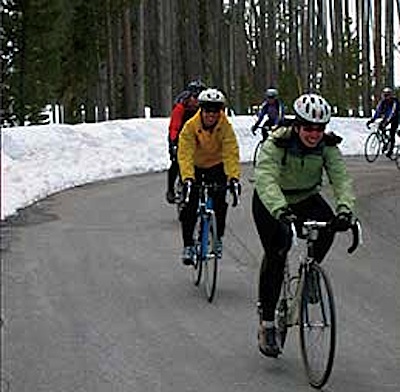If you're looking for an incredible springtime bike ride in the national parks, head to Yellowstone National Park, where you can pedal between West Yellowstone, Montana, and Mammoth Hot Springs in April without sharing the road with private vehicles.
Plowing operations are under way in the park during the month of April as crews work to clear away the snow in time for the spring season. But until late in the month, the general public normally isn't allowed to drive into the park (outside of the road from Mammoth Hot Springs to Cooke City, Montana, which is open year-round). As a result, from early April until the last few days of the month, cyclists can enjoy the fresh air and sights.
The ride from West Yellowstone to Mammoth Hot Springs takes you along the Madison River, by the Monument Geyser Basin, past the Norris Geyser Basin, and past Roaring Mountain as well as Obsidian Cliff. Along with these wonders, there always is some wildlife out and about to spy.

April can be a chilly month in Yellowstone, but it also can be a great time to pedal in the park. NPS photo.
Of course, the downside is your ride will turn into a 100-mile roundtrip unless you figure out a shuttle. Or, you could add panniers to your bike, take camping gear, overnight in the Mammoth Campground, and reverse your ride the following day. If you're thinking the Mammoth Hot Springs Hotel might have a room, it's closed until early May.
As always, a bicycle trip into Yellowstone this time of year is not to be undertaken lightly. The quickly changing weather can be challenging, and snow and ice may still cover sections of road. Bears, bison, elk, wolves and other wildlife could be encountered at any time. No services are available along these sections of road, and cyclists should expect to encounter and yield to snowplows or other vehicles operated by park employees or construction workers traveling in conjunction with park operations.
Bicyclists are required to ride single file and follow all other rules of the road. They are strongly encouraged to carry bear spray, should be prepared to turn around and backtrack when encountering wildlife on the road, and must stay out of closed areas.
Riders need to have a plan for self rescue or repair and be prepared to be out in severe winter conditions for an extended period of time in the event they experience a mechanical breakdown, injury or other emergency. Cell phone coverage throughout the park is sparse and unreliable for communicating emergencies.
Cyclists are urged to call 307-344-2107 from 8 a.m. to 4:30 p.m. on weekdays for updated road access information, or call 307-344-2113 for 24-hour weather information before committing to any park ride. Additional planning information is also available online at http://www.nps.gov/yell/planyourvisit/springbike.htm.


